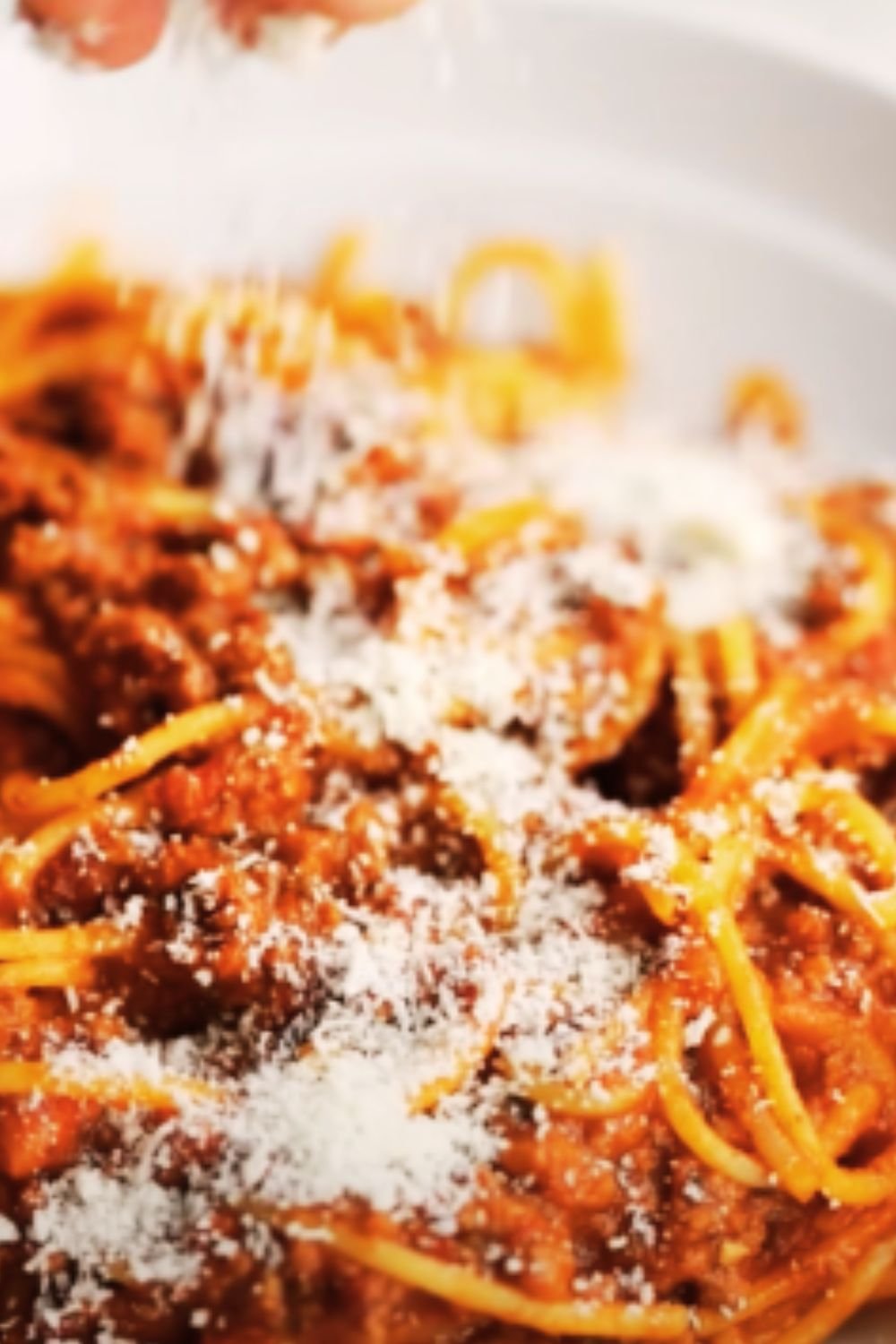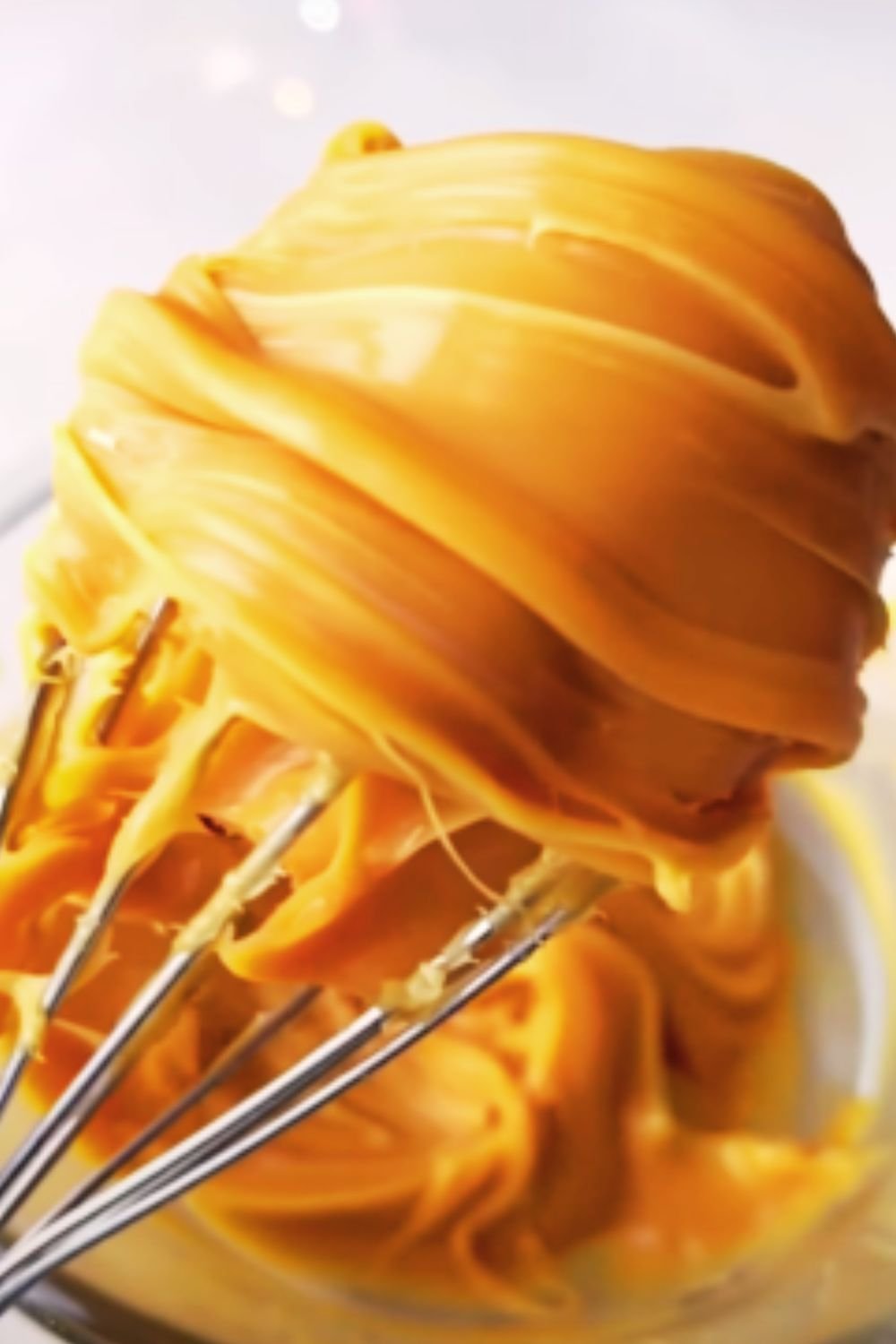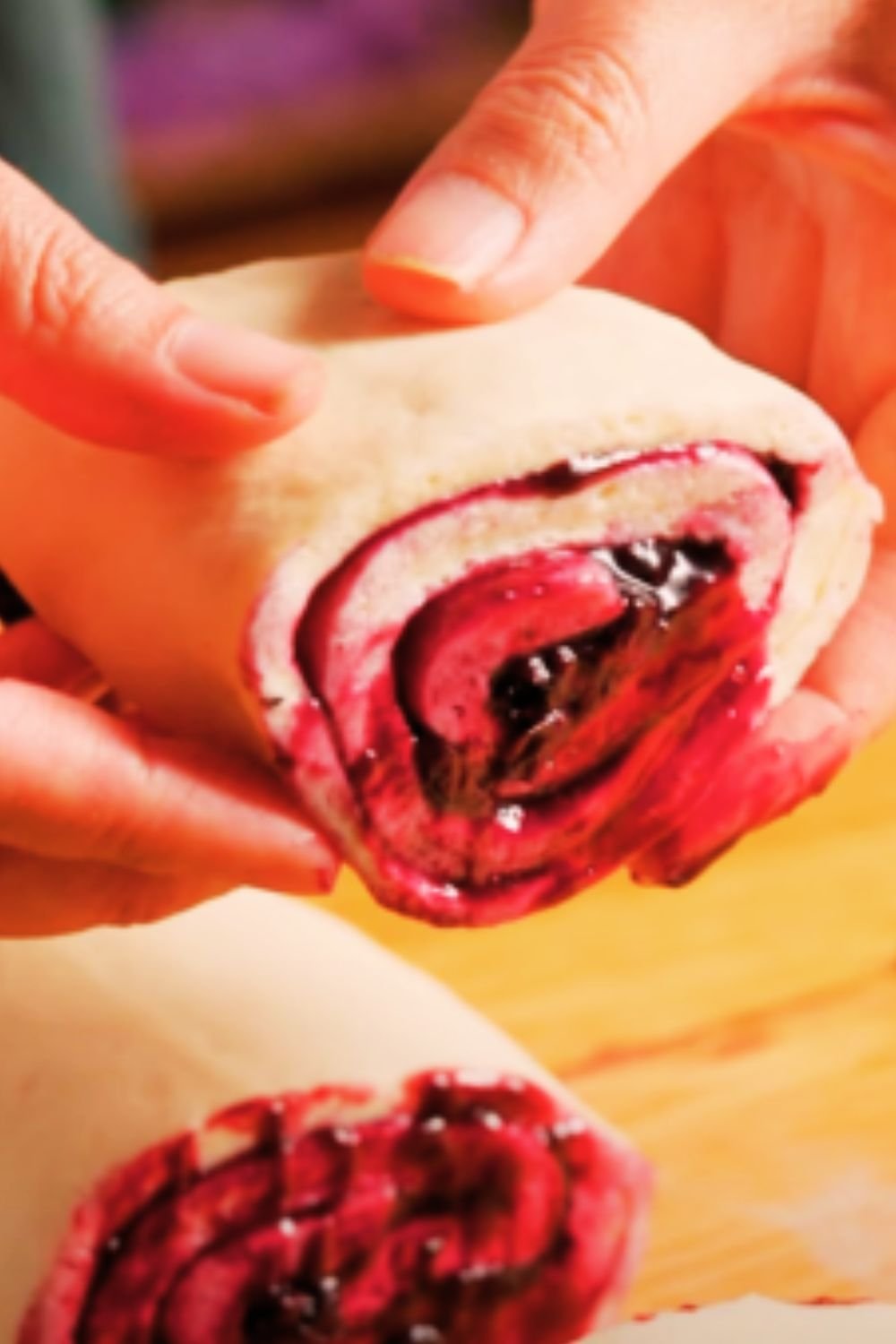There’s something irresistible about a plate of perfectly cooked spaghetti coated in a rich, spicy sauce that makes your taste buds tingle with excitement. I’ve spent years perfecting my spicy spaghetti recipe, and today I’m thrilled to share this culinary gem with you. This isn’t your ordinary pasta dish – it’s a flavor explosion that combines traditional Italian techniques with a fiery kick that will have you coming back for seconds (and thirds!).
Growing up in a household where meals were the centerpiece of family gatherings, I learned early on that food isn’t just sustenance – it’s an experience. My journey with this spicy spaghetti recipe began during my college years when I was experimenting with ways to elevate simple, budget-friendly meals. What started as a necessity-driven cooking adventure has evolved into one of my signature dishes that friends and family specifically request whenever they visit.
The beauty of this spicy spaghetti recipe lies in its versatility. You can adjust the heat level to suit your preference, add protein like Italian sausage or shrimp for extra heartiness, or keep it vegetarian for a lighter option. The complex layers of flavor come from building the sauce thoughtfully, allowing each ingredient to contribute its unique character to the final masterpiece.
Ingredients: The Foundation of Flavor
Before we dive into the cooking process, let’s gather our ingredients. The quality of your ingredients will significantly impact the final result, so I recommend using the freshest produce you can find and investing in good quality olive oil and pasta.
For the Spicy Sauce:
- 2 tablespoons extra virgin olive oil
- 1 large onion, finely diced
- 6 cloves garlic, minced
- 2-4 fresh red chili peppers, finely chopped (adjust according to your heat preference)
- 1 red bell pepper, diced
- 2 tablespoons tomato paste
- 2 teaspoons crushed red pepper flakes (adjust to taste)
- 1 teaspoon dried oregano
- 1 teaspoon dried basil
- 1/2 teaspoon dried thyme
- 2 bay leaves
- 1 can (28 oz) San Marzano tomatoes, crushed
- 1/4 cup fresh basil leaves, torn
- 1 tablespoon balsamic vinegar
- 1 teaspoon sugar (balances acidity)
- Salt and freshly ground black pepper to taste
For the Pasta:
- 1 pound (16 oz) high-quality spaghetti
- 2 tablespoons salt (for pasta water)
For Garnish:
- Fresh basil leaves
- Freshly grated Parmesan cheese
- Red pepper flakes
- Drizzle of extra virgin olive oil
Equipment Needed
Preparing this delicious spicy spaghetti requires some basic kitchen equipment:
- Large pot for boiling pasta
- Large, deep skillet or saucepan for the sauce
- Sharp knife and cutting board
- Measuring cups and spoons
- Wooden spoon for stirring
- Colander for draining pasta
- Tongs for tossing pasta
Understanding Heat Levels: A Guide to Spicing Up Your Spaghetti
One of the most important aspects of making spicy spaghetti is understanding how to control the heat level. Here’s my guide to help you navigate your spice journey:
Mild: Use 1 fresh chili pepper, deseeded, and 1/2 teaspoon of red pepper flakes Medium: Use 2 fresh chili peppers and 1 teaspoon of red pepper flakes Hot: Use 3-4 fresh chili peppers with seeds and 2 teaspoons of red pepper flakes Extreme: Add 1/4 teaspoon of cayenne pepper to the hot version
Remember that the heat develops as the sauce cooks, so it’s always better to start with less and add more later if needed. I always taste the sauce throughout the cooking process and adjust the seasonings accordingly.
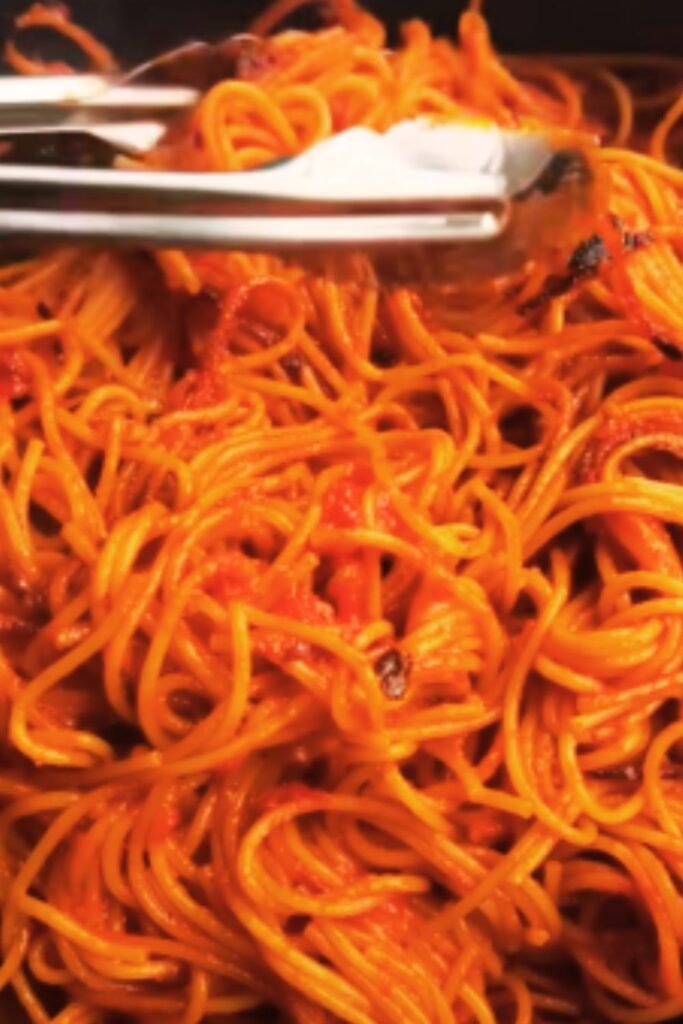
The Secret to Perfect Spicy Spaghetti: Detailed Steps
Now that we have our ingredients and equipment ready, let’s dive into the step-by-step process of creating this mouthwatering spicy spaghetti.
Step 1: Prepare Your Ingredients
I always begin by preparing all my ingredients before I start cooking. This French technique, called “mise en place,” ensures a smooth cooking process without any last-minute scrambling.
- Dice the onion and bell pepper
- Mince the garlic
- Finely chop the chili peppers (wear gloves if you’re sensitive to capsaicin)
- Tear the fresh basil leaves
- Measure out all dry spices and have them ready
Step 2: Start the Sauce Base
The foundation of a great spicy spaghetti sauce is building layers of flavor from the beginning.
- Heat olive oil in a large, deep skillet over medium heat
- Add diced onions and cook until translucent, about 5 minutes
- Add minced garlic and cook for another minute until fragrant (be careful not to burn the garlic as it will turn bitter)
- Add chopped chili peppers and diced bell pepper, cooking for 3-4 minutes until they begin to soften
Step 3: Develop the Flavor Profile
This is where the magic happens – we’re going to add the ingredients that give our sauce its distinctive character.
- Add tomato paste and stir continuously for 2 minutes to caramelize it slightly
- Sprinkle in the dried herbs (oregano, basil, thyme) and red pepper flakes, stirring to toast them lightly and release their aromatic oils
- Add the crushed San Marzano tomatoes, bay leaves, sugar, and balsamic vinegar
- Season with salt and freshly ground black pepper
- Stir thoroughly to combine all ingredients
Step 4: Simmer to Perfection
Patience is key for developing deep flavor in the sauce.
- Bring the sauce to a gentle boil, then reduce heat to low
- Simmer uncovered for at least 30 minutes, stirring occasionally
- For an even richer flavor, simmer for up to an hour (add a splash of water if it becomes too thick)
- The sauce should reduce and thicken slightly, with the flavors intensifying
- Remove bay leaves and stir in fresh torn basil leaves in the last 5 minutes of cooking
Step 5: Cook the Pasta to Al Dente
Perfect pasta is the foundation of exceptional spaghetti.
- Fill a large pot with water (about 4 quarts)
- Add 2 tablespoons of salt once the water comes to a boil (the water should taste like seawater)
- Add the spaghetti and cook according to package instructions, but aim for 1 minute less than recommended time for perfect al dente texture
- Reserve 1 cup of pasta water before draining
- Drain pasta but do not rinse (the starch helps the sauce adhere)
Step 6: Marry the Pasta and Sauce
The final step is all about creating harmony between the pasta and sauce.
- Transfer the drained pasta directly to the sauce
- Use tongs to toss the pasta thoroughly in the sauce
- Add a splash of reserved pasta water (about 1/4 cup) to help the sauce coat the pasta evenly
- Continue tossing for 1-2 minutes until each strand is perfectly coated and the sauce has slightly thickened
- If needed, adjust seasoning with salt and pepper
Serving Suggestions and Presentation
How you serve your spicy spaghetti can elevate it from a simple meal to a restaurant-quality dining experience. Here are my favorite ways to present this dish:
- Use warmed plates to keep the pasta hot longer
- Twirl the spaghetti with tongs to create height in the center of the plate
- Garnish with fresh basil leaves, a sprinkle of freshly grated Parmesan, and a light dusting of red pepper flakes
- Drizzle with a small amount of high-quality extra virgin olive oil
- Serve immediately with crusty garlic bread on the side
Variations to Try: Making the Recipe Your Own
One of the things I love most about cooking is the opportunity to personalize recipes. Here are some delicious variations you might want to try:
Protein Additions:
- Italian sausage: Brown 1 pound of spicy Italian sausage with the onions
- Shrimp: Add 1 pound of peeled and deveined shrimp in the last 3-4 minutes of sauce simmering
- Chicken: Add 1 pound of diced chicken breast after the onions and cook until no longer pink
- Pancetta: Add 4 oz of diced pancetta with the onions for a smoky flavor profile
Vegetable Enhancements:
- Mushrooms: Add 8 oz of sliced cremini mushrooms with the bell peppers
- Spinach: Stir in 2 cups of fresh spinach in the last minute of cooking
- Roasted eggplant: Fold in 1 cup of diced roasted eggplant before adding the tomatoes
- Zucchini: Add 1 medium diced zucchini with the bell peppers
Flavor Twists:
- Smoky: Add 1/2 teaspoon of smoked paprika with the dried herbs
- Creamy: Stir in 1/4 cup of heavy cream at the end of cooking
- Tangy: Add 2 tablespoons of capers with the tomatoes
- Herbaceous: Double the fresh herbs and add 1 tablespoon of fresh oregano
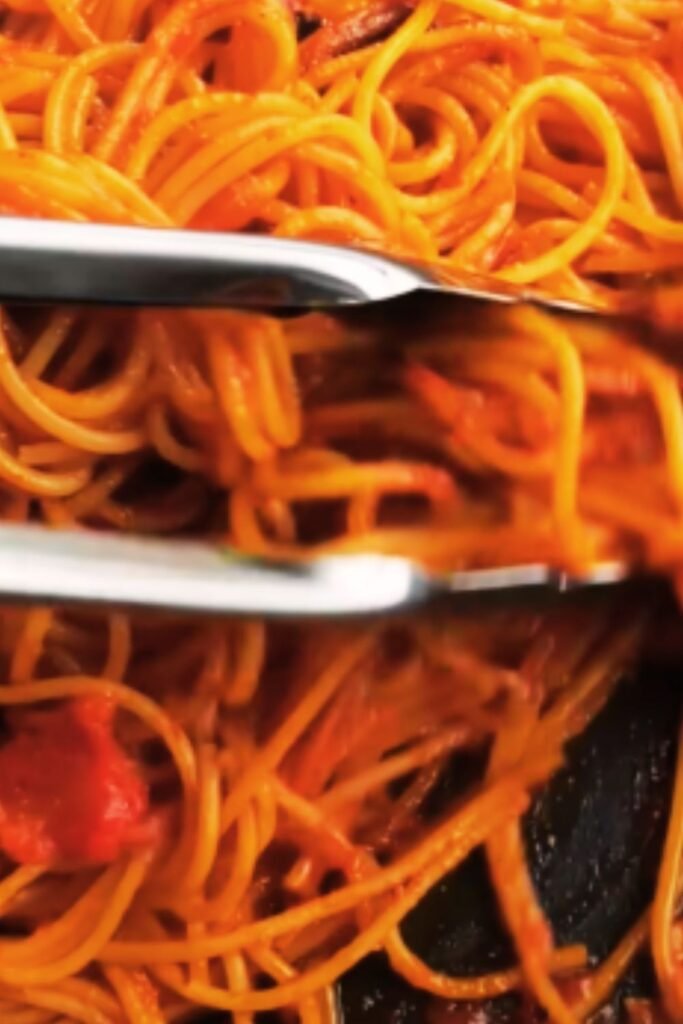
Nutritional Information
Understanding the nutritional content of your meals is important for maintaining a balanced diet. Here’s a detailed breakdown of the nutritional information for one serving of this spicy spaghetti recipe (based on 4 servings total):
| Nutrient | Amount | % Daily Value* |
|---|---|---|
| Calories | 420 | – |
| Total Fat | 9g | 12% |
| Saturated Fat | 1.5g | 8% |
| Trans Fat | 0g | – |
| Cholesterol | 0mg | 0% |
| Sodium | 580mg | 25% |
| Total Carbohydrates | 72g | 26% |
| Dietary Fiber | 5g | 18% |
| Sugars | 8g | – |
| Protein | 12g | 24% |
| Vitamin A | – | 20% |
| Vitamin C | – | 45% |
| Calcium | – | 6% |
| Iron | – | 15% |
*Percent Daily Values are based on a 2,000 calorie diet
Storage and Reheating Tips
I often make a double batch of this sauce since it stores beautifully and tastes even better the next day as the flavors continue to meld. Here’s how to properly store and reheat your spicy spaghetti:
Storage:
- Sauce only: Allow to cool completely, then store in an airtight container in the refrigerator for up to 5 days or freeze for up to 3 months
- Pasta and sauce together: Store in an airtight container in the refrigerator for up to 3 days
Reheating:
- Stovetop (preferred method): Place in a skillet over medium-low heat with a splash of water, stirring occasionally until heated through
- Microwave: Place in a microwave-safe container with a splash of water, cover with a damp paper towel, and heat in 30-second intervals, stirring between each until hot
- From frozen: Thaw sauce overnight in the refrigerator before reheating using either method above
Troubleshooting Common Issues
Even experienced cooks sometimes encounter challenges. Here are solutions to common problems you might face when making spicy spaghetti:
Too Spicy:
- Add more crushed tomatoes to dilute the heat
- Stir in 1-2 tablespoons of heavy cream or coconut milk
- Serve with a cooling side like a simple green salad with ranch dressing
Too Acidic:
- Add another 1/2 teaspoon of sugar
- Stir in 1/4 teaspoon of baking soda to neutralize acidity
- Add a tablespoon of butter at the end of cooking
Too Thick:
- Add more pasta water, 2 tablespoons at a time
- Add a splash of regular water or vegetable broth
Too Thin:
- Continue simmering uncovered until desired consistency is reached
- Mix 1 teaspoon of cornstarch with 1 tablespoon of cold water and stir into the sauce
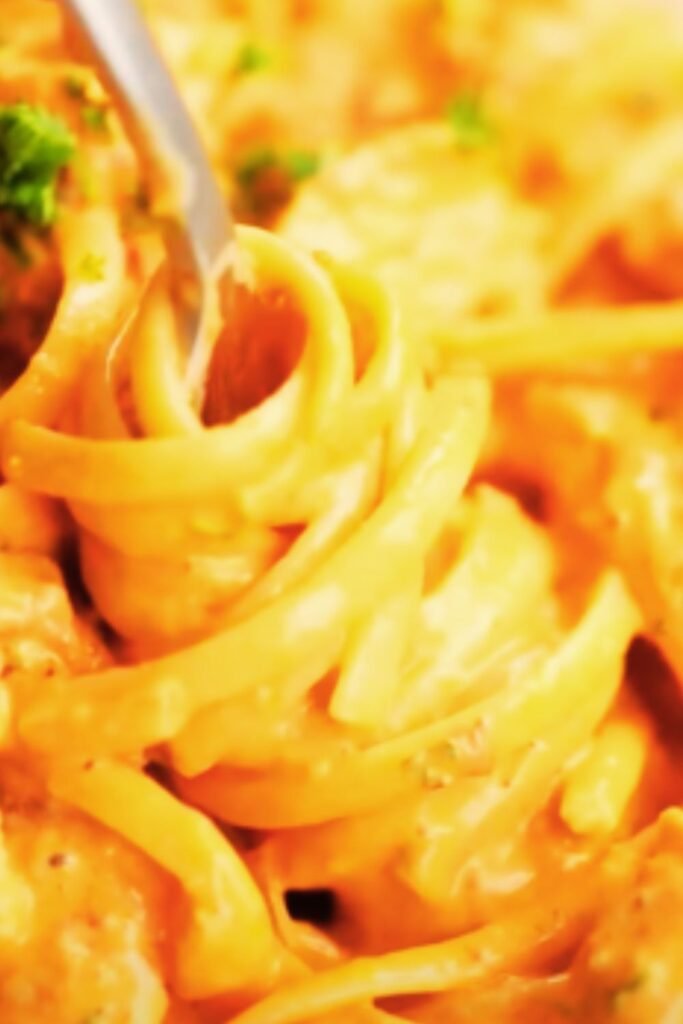
Why This Recipe Works: The Science Behind Great Spicy Spaghetti
I’m fascinated by food science, and understanding why certain techniques work helps me become a better cook. Here’s why this spicy spaghetti recipe delivers exceptional results:
Building Flavor Layers:
Starting with sautéed aromatics (onions, garlic) creates a flavor foundation. The oil-soluble compounds in these ingredients infuse the olive oil, which then distributes these flavors throughout the dish.
The Role of Tomato Paste:
Caramelizing the tomato paste before adding liquids converts some of the natural sugars through the Maillard reaction, creating deeper, more complex flavors.
Balancing Heat:
Using both fresh chili peppers and dried red pepper flakes provides immediate heat and a slow-building warmth. The capsaicin in peppers is fat-soluble, which is why the heat distributes evenly throughout the oil-based sauce.
The Importance of Simmering:
The longer cooking time allows for greater flavor development through the release of glutamates (umami compounds) from the tomatoes, especially San Marzano varieties which are naturally higher in these flavor-enhancing compounds.
Pasta Water Magic:
The starchy pasta water contains dissolved starches that act as a natural thickener and emulsifier, helping the sauce cling to the pasta and creating a silky texture.
Frequently Asked Questions
As someone who has taught this recipe to many friends, I’ve compiled answers to the questions I hear most often:
Q: Can I make this recipe less spicy but still flavorful? Absolutely! The foundation of this sauce is delicious even without the heat. Simply omit the fresh chili peppers and reduce the red pepper flakes to just a pinch, which will provide depth without significant heat. The balsamic vinegar, herbs, and slowly simmered tomatoes will still create a rich, flavorful sauce.
Q: What type of pasta works best with this sauce? While I recommend spaghetti, this sauce works wonderfully with any long pasta like linguine, fettuccine, or bucatini. The sauce clings beautifully to these shapes. If you prefer shorter pasta, rigatoni or penne are excellent choices as their tubes capture pockets of the spicy sauce.
Q: Can I make this sauce ahead of time? This is one of those magical recipes that actually improves with time! You can make the sauce up to 3 days ahead and store it in the refrigerator. The flavors will continue to develop and meld, resulting in an even more delicious final dish. Just cook fresh pasta when you’re ready to serve.
Q: How can I make this recipe vegan? This recipe is naturally vegan if you skip the Parmesan garnish or replace it with a plant-based alternative. There are several excellent vegan Parmesan-style toppings available commercially, or you can make your own by blending nutritional yeast, cashews, garlic powder, and salt.
Q: What sides pair well with spicy spaghetti? I love serving this with a cooling side dish to balance the heat. A simple green salad with a lemon vinaigrette, garlic bread, or roasted vegetables like zucchini or broccoli complement the spicy flavors beautifully. For a complete Italian-inspired meal, start with a caprese salad as an appetizer.
Q: Why do you add sugar to the sauce? A small amount of sugar helps balance the natural acidity of the tomatoes, resulting in a more rounded flavor profile. It doesn’t make the sauce sweet but rather harmonizes all the flavors. If your tomatoes are particularly sweet (as some San Marzano varieties can be), you might be able to reduce or omit the sugar.
Q: Can I use canned diced tomatoes instead of crushed? Yes, you can substitute diced tomatoes, but I recommend pulsing them briefly in a blender or food processor first, or crushing them by hand as you add them to the pot. Alternatively, you can use whole peeled tomatoes and crush them with your hands for a more rustic texture in the final sauce.
A Personal Note: Why I Love This Recipe
I’ve made this spicy spaghetti recipe countless times over the years, tweaking and perfecting it along the way. What I love most about it is how it brings people together around the table. There’s something about a steaming plate of pasta that encourages conversation and connection.
This dish has been the centerpiece of many memorable evenings in my home – from casual weeknight dinners to special celebrations. I’ve watched friends who “don’t like spicy food” take second and third helpings, and I’ve seen children (with a milder version, of course) develop an appreciation for flavors beyond the standard kid-friendly fare.
Cooking is one of the most meaningful ways I express care for the people in my life, and this spicy spaghetti recipe has become one of my favorite ways to do that. The process of creating it – from the first sizzle of onions in olive oil to the final garnish of fresh basil – brings me joy every time.
I hope this recipe finds a place in your cooking repertoire and brings as much delight to your table as it has to mine. Remember, cooking is about making the recipe your own, so feel free to adjust and experiment until it perfectly suits your taste.
Happy cooking, and even happier eating!

